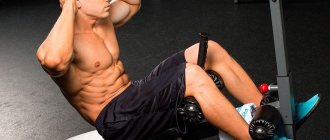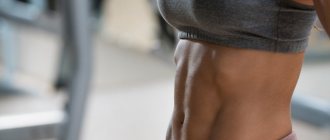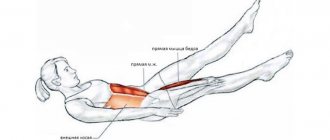Most likely, you know that the abs are a single rectus abdominis muscle. But there are exercises with an emphasis on its lower part, which is why they got their name. We present to you super-effective lower abdominal exercises for men and women that work on the most problematic area - the lower abdomen.
Anatomical features of the press
First of all, we need to understand that we conditionally divide the press into zones. Since it is one whole muscle called the rectus abdominis muscle. And during any exercise it is fully involved. You can learn how to shift the emphasis to the upper part from the article “EXERCISES FOR THE UPPER PRESS“. The main problems in its development occur for several reasons:
Weak abdominal muscles
It is clear that if the abdominal muscles are not developed, then it is unlikely that one can boast of their ideal development. But if the upper part of the abs is easy to train (the area above the navel), then the lower part lags behind in this regard. To develop the lower region, any exercise in which we twist the pelvis is suitable. Also, we must remember that in any exercise the press works to maintain the position of the body, but the load on it is static. If you make an effort to develop your lower abs, you can remove your belly, making your waist flat.
Fat layer
Fat is the fear of any girl who cares about her appearance and wants to always be beautiful. The problem is that we cannot remove it in those places that we consider problematic. If a girl has most of her fat deposited in her thighs (that’s why they have cellulite). In men, the belly grows first. It’s not for nothing that the expression “Beer Belly” appeared about them. And in order to get rid of all these excesses, abdominal training alone will not be enough. You will have to use the heavy artillery consisting of proper diet and cardio training.
Excessive slouching
Now this is the peak problem of modern people. All because of sedentary work at the computer. Also, mobile phones force us into crooked postures. Many people do not part with their gadgets even in the hall. And all this makes us unattractive. And visually turns our abs into a wrinkled fat lump. If your posture is straight, then the rectus muscle will be stretched like a string. And your abs will shine with their appearance.
Conclusion: if you want to work out your lower abs as much as possible, then you need to work in several directions. Namely: nutrition, cardio exercises and exercises directly aimed at increasing the rectus abdominis muscle.
Variety of approaches to performing exercises
You can easily pump up your lower abs on the floor - without additional objects or exercise equipment. You can also use additional sports equipment:
- Horizontal bar;
- Sticks;
- Swedish wall;
- Dumbbells;
- Rubber;
- Tapes;
- Balls;
- Jump ropes.
You can choose the best exercises with the help of a trainer or on your own.
The goal is to strengthen the muscle tissue of the lower abs. These actions will promote better tissue circulation and nutrition of every cell in the muscle frame and around the muscle tissue.
The best and simplest exercises are considered to be sitting, kneeling, lying on your stomach and back.
Cardio load
Cardio training is aimed at burning fat and developing the heart muscle. You can choose any direction: running, swimming, jumping, fast walking, as well as training on special simulators. It doesn't matter which of these directions you choose. The main thing is the right approach and regularity in training.
- Know the lower and upper range of your heart rate. And maintain it in these ranges
- Do cardio only at the end of your workout or on non-training days so as not to interfere with your muscle growth progress.
- The duration of the workout should be 30-40 minutes 3-5 times a week
- Only strength training combined with cardio effectively burns fat.
And remember a lot of cardio does not mean good. Everything should be in moderation. You are not a machine, so you approach everything wisely.
Belly fat
With age, muscle mass slowly decreases, and the fat component increases. You may notice an increase in belly fat even if you are not gaining weight. This is due to a decrease in estrogen levels, which affects the distribution of fat in your body.
Research shows that if the greatest accumulation of fat is in your lower abdomen, the so-called “lifeline,” then the risk of heart disease increases significantly. These people have a significant increase in metabolic risk factors: high blood sugar, high triglycerides and cholesterol.
Another study found that premenopausal women with significant amounts of belly fat have a higher risk of developing breast cancer than women with less abdominal fat. Therefore, it is imperative to fight excess fat and prevent it from accumulating in the body through proper nutrition and physical activity.
Diet and abs
As you already understand, the abs will not appear from under a layer of fat thanks to training alone. To manifest it, you need to adhere to the right diet. It is she who, together with training, will start the fat burning process. This is not difficult to achieve, the main thing is to make proper nutrition a part of your life. And then your abs will always be in sight. The main points include:
- Eat protein foods with low fat content: chicken, veal, beef, etc.
- Drink plenty of water. At least 2 liters per day.
- Give preference only to complex carbohydrates: cereals and legumes.
- Take enough vitamins and minerals. You can find them in vegetables and fruits.
- Eliminate sweets and alcohol from your diet.
These are important points that will help you start mastering your diet correctly. You can find out more information in the article “Principles of Proper Nutrition”.
Lesson mode
We discussed how to pump up the lower abdominal muscles above, but in order for the sport to bring results, consistency is necessary. You can limit yourself to 3-4 classes per week, which will last no more than half an hour. Fitness experts advise pumping your lower abs every 16 hours. But this can be difficult for beginners, so be guided by the state of your body, since frequent exercise can cause overtraining, which leads to injuries.
Following the recommendations, evaluate the result after a few months.
Lower abs exercises. Static, isometric and dynamic load
Exercises for the lower abs can be divided into 3 types: static, isometric and mechanical. If you want to build beautiful core muscles, you should use all three types of training. They will help make your abs strong and give them definition.
Static
Static exercises are exercises in which the muscles tense without moving the joints. That is, our task is to take the correct position, tense the muscle we need (in our case, the abs) and hold it in this position for a certain time. Why should we do this? It's simple, static load makes muscles stronger. Also strengthens ligaments and tendons.
Corner
This is an excellent static exercise for working your lower abs. It is performed lying on the floor on a special yoga mat.
Performance:
- Lie on your back, place your arms along your body or behind your head. The shoulder blades are pressed.
- From this position, lift your aligned legs 20-40 centimeters from the floor.
- Tighten your abdominal muscles as much as possible and hold in this position for 20-50 seconds.
- Afterwards, relax for a while and repeat 4-6 times.
Try to breathe evenly and not move your legs. At first it will be very difficult to hold this position for a long time, but over time the muscles will get stronger.
Angle hanging on the crossbar
The hanging corner is a more advanced version of the regular corner. The meaning is almost the same, only we will bend our legs at 90°. This exercise perfectly works the lower part of the press, making it as strong as possible.
Performance:
- Hang from the bar. We keep our arms straight. Let's look ahead.
- From this position, we raise our legs to an angle of 90°.
- Raising your legs, tighten your abdominal muscles and lock in this position for 20-50 seconds.
- Once the time is up, relax with your legs down. Repeat 2-5 times.
If you immediately cannot keep your legs straight on the bar, then do the same exercise on the uneven bars or on the gymnastic ladder.
Plank with leg up
For the purposes of this article, we are interested in one of the many varieties of the plank, namely with one leg raised up. It is she who maximally loads the lower sections of the press.
Performance:
- Take a push-up position with your hands on your elbows.
- Straighten your body, it should be taut like a guitar string. Don't hunch or bend your lower back.
- Lift one of your legs off the floor and lift it up. So that it is flush with the body.
- Tighten your abs and hold yourself in this position for 20-40 seconds. Then change leg and repeat the same thing.
- Rest a little and repeat the exercises. Do 2-3 approaches on each leg.
The plank is an excellent exercise for developing endurance and abdominal strength. If you don't want to do crunches or don't feel your abs well in them, then this exercise is for you. Also be sure to try other plank options.
Isometric
Isometric exercises are practically the same as static exercises, only the tension in the muscles occurs briefly and is performed a certain number of times. That is, we also take a certain position and strain the muscles we need.
Attention: our task is only to shorten the desired muscle area, and not to perform a mechanical movement.
There are great isometric exercises that you can do both in the gym and at home.
Exercise No. 1
Sit on a bench or chair. Place two hands near your abs. Round your back as if you were doing an abdominal crunch. This will be the starting position, in which we will remain throughout the entire exercise.
- Taking a sharp exhalation, tighten your abs and at the same time begin to press on it with your hands. What is important is not the effort you apply, but the maximum tension of the press.
- Hold for 5 seconds and while inhaling, relax, but do not change your position. We do 3 sets of 10-12 times.
Exercises No. 2
Sit on a bench or chair with your feet flat on the floor at a 90° angle. Place your hands on your knees. Your back is straight, don't slouch. The gaze is directed forward.
Performance:
- Imagine as if you are trying to lift your leg, but your hand won’t let you do it. This is a very important point!
- On the side of the leg you want to lift, while exhaling, tighten your abs for 5 seconds.
- As you inhale, relax. Repeat the specified number of times and change legs.
- We do 3 sets of 10-12 repetitions.
Important! You don't really have to make a big effort to lift your leg or stop your hand from doing so. Our task is to focus on the area of the press that we are straining. We remain motionless throughout the entire exercise.
Exercise #3
This exercise has no starting position. It can be performed standing, sitting, lying down. The main thing is that you feel the tension of the press and its relaxation. And of course, we didn’t fall asleep while doing it while lying down.
Performance:
- Take a comfortable starting position.
- As you exhale, tighten your abdominal muscles and hold for 5 seconds.
- As you inhale, relax your abdominal muscles.
- Repeat 3 sets of 10-15 reps.
This exercise can be performed at least every day, several times. It will tighten your stomach, strengthen your lower abs and sides.
Dynamic
Dynamic exercises are those that work the joints and their movement affects the abdominal muscles. In our case it will be the hip joint.
All dynamic exercises can be divided into 3 levels of difficulty:
- Elementary. This is the simplest version of the exercise. If you have never done this movement, then it is better to start with it. And after you master the technique, move on to a more complex version.
- Average. An intermediate level exercise helps prepare for the hardest. Strengthens the abdominal muscles. It also improves the neuromuscular connection between the brain and the work of the lower rectus abdominis muscle.
- Difficult. If you have made it this far and are doing it with proper technique. Then I can congratulate you, your lower abs are progressing and growing. Continue in the same spirit.
We start with the beginner level and gradually move towards the complex ones. This may take more than one workout, so don't rush. The main thing is to perfect the technique.
Exercises
The main point when choosing exercises for the lower abs is the work of the lower torso. That is, we must bring the pelvis to the chest, or work with our legs.
Climbing a mountain (entry level)
This is a simple but very effective exercise for developing the lower abs. It can be performed both at home and in the gym.
Performance:
- Lie down as if you were doing push-ups, but place your hands shoulder-width apart.
- As you exhale, pull your leg towards the arm of the same name (that is, left leg to left leg). At the same time, round your back a little to tighten your abs more.
- As you exhale, return your leg to the starting position. Alternate legs until you've done 10-12 reps on each side.
Your main task is not speed, but contraction and stretching of the abdominal muscles. Therefore, we try to do everything slowly and under control. Only then will we achieve great results from this exercise.
Cross mountain climb (intermediate level)
In principle, these two exercises are similar to each other. Only in this option will the oblique abdominal muscles also work, which give the V-shape to the lower part of the abs. But before moving on to it, you must master the initial exercise perfectly. This way you will understand the technique. And also, what kind of load does your abs receive?
Performance:
- Take the starting position the same as in the first option (push-ups, hands shoulder-width apart).
- As you exhale, stretch your left leg towards your right hand. At the same time, we round our back a little and do twisting in the side and lower part of the press. As you exhale, we return to the starting position. And then we pull the right leg towards the left hand.
- We continue alternating until we do 10-12 times for each side.
Try to focus your attention on the work of the lower and side parts of the press. If you don’t feel them, then go back to simple hill climbs and learn to feel the work of your abs.
Climbing a mountain with an elastic band (difficult level)
This is a more advanced version of mountain climbing, as resistance from the elastic band is added. This option will help to achieve maximum involvement of the lower press in the work. And also strengthen the oblique abdominal muscles. Together with diet and cardio training, you can change the appearance of your abs.
Performance:
- First, you need to secure one edge of the elastic. It doesn’t matter what you attach it to. This could be a ladder or the edge of a squat rack. The main thing is that the surface does not move during execution.
- Take a lying position as if you were about to do push-ups, with your hands shoulder-width apart.
- Insert the edge of your left foot into the elastic band. And bend your foot slightly towards the heel so that it doesn’t pop out.
- As you exhale, we pull the left leg towards the arm of the same name. While inhaling, we return to the starting position. We do the same for the right leg. At the same time, we round the back.
- We alternate legs until we do it 10-12 times.
The main thing is to avoid rushing, or the elastic will constantly slide off the foot. As for the fitness elastic band, it comes in different hardnesses. Unfortunately, if there are any in the halls, it is unlikely that there will be a large variety of them. Therefore, it is better to buy it yourself with the required rigidity.
Knee raises on parallel bars (entry level)
Although the exercise is called knee lifting, we must remember that in order for the abs to work, we must do twisting. If we work only with our legs, then the movement will occur due to the hips. This exercise is isolated due to the emphasis on the back.
Performance:
- Place your elbows on the bars. Press your back against the backrest. I think that now every modern gym is equipped with special bars on which you can pump up your abs.
- As you exhale, contract your abs and lift your legs bent at the knees as far as possible towards your chest.
- As you inhale, return to the starting position.
As far as you have noticed, the technique is very simple. The main task is to eliminate all kinds of jerking movements. They will not be useful and will not give the desired result.
Knee raises on the bar (intermediate level)
This option is a more complex version of the first for several reasons:
Firstly, there is no support for the back, so we will have to support the body ourselves. Secondly, there is a large load on the forearms due to the hanging position. Therefore, some simply will not be able to hang on the bar for a long time. Thirdly, not everyone wants strong forearm development; this applies more to the female sex. Fortunately, all these problems can be solved with the help of Berisha loops. You can see them in the photo below. They compensate for all the disadvantages, unless of course they bother you.
Performance:
- Hang from the bar, or from Beres' loops. Bend your legs at the knees.
- As you exhale, twist your abs, lifting your legs up and bringing your pelvis forward.
- As you inhale, lower your legs, stretch your abs, but do not relax them completely.
- Repeat 10-12 times.
The main thing is to swing on the bar; the work should take place only in the lower part of the press.
Raising straight legs on the crossbar (difficult level)
Leg raises on the bar are the most effective exercise in developing the lower abs. Throughout the entire exercise, our abs are in a stretched state, so they receive a huge load even in the lower negative phase. Before you start, work out your abs on the first two options. I do not recommend using Berisha loops in this exercise, as it will be difficult to raise straight legs in this position.
Performance:
- Hang from the bar. Straighten your arms and legs. Press your feet together.
- As you exhale, lift your legs up until they touch the bar. We try to keep our legs straight when lowering and lifting.
- As you exhale, lower your legs down, but do not relax your abdominal muscles completely.
- Repeat as many times as necessary. Usually this is 10-12 repetitions.
Try not to sway and raise your legs by tensing your abdominal muscles. There is no need to throw them using inertia.
Alternately raising legs from a lying position (initial level)
An excellent entry-level option. Perfect for every athlete, regardless of gender and level of training. The exercise is isolated, as your back lies on the floor.
Performance:
- Lie on the floor with a yoga mat under your back. The shoulder blades are brought together, the arms are extended along the body. If this is very easy for you to do, put them behind your head.
- As you exhale, lift one of your legs up to an angle of 45-60°. Hold it in this position for a couple of seconds and lower it down.
- As soon as the foot touches the floor with the heel, you can lift the second one.
As you can see, there is nothing complicated, the main thing is to try to lift your leg by contracting the rectus abdominis muscle. For better results, you can slightly raise your shoulders in the starting position.
Leg raises lying on the floor (intermediate level)
This option is more complex. They are no different from the first one, but now our task is to lift two legs at the same time. At the same time, we will lose one point of support, so it will become more difficult to maintain balance.
Performance:
- Lie on the mat, shoulder blades together, arms along the body. The head is on the floor.
- As you exhale, raise both legs to an angle of 45-60°. Hold it a little and lower it down as you inhale.
Don't make sudden movements. Focus on working your lower abs.
Exercises with leg raises in a lying position
There are a large number of effective exercises for the lower abs, such as:
- "bicycle";
- "scissors".
Despite the differences, they provide the same load on the muscles. Well suited for pumping up the lower abs, especially to complete a workout (performed to failure).
Choose an exercise that you can perform without errors in technique and at least 30 repetitions in one set.










